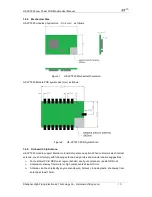
HF-LPT220 Low Power WiFi Module User Manual
Shanghai High-Flying Electronics Technology Co., Ltd(www.hi-flying.com)
- 14 -
<Notes>
When bootup, module PIN4/5/9 must be high.
I
— Input
;
O
— Output
PU
—Internal 4.7K Resistor Pull Up
;
PD
—Internal Pull Down
;
I/O: Digital I/O
;
Power
—
Power Supply
nReload Pin (Button) function
:
1.
When this pin is
set to “low” during module boot up, the module will enter wireless
firmware and config upgrade mode. This mode is used for customer manufacture.
(See Appendix C to download software tools for customer batch configuration and
upgrade firmware during mass production)
2.
After module is powered up, short press this button
( “Low” < 2s ) to make the
module
go into “Smart Link “ config mode, waiting for APP to set password and
other information. (See Appendix C to download SmartLink APP)
3.
After module is powered up, long press
this button ( “Low” >= 4s ) to make the
module recover to factory setting.
High-Flying strongly suggest customer fan out this pin to connector or button for
“Manufacture” and “ Smart Link” application.
nLink Pin (LED) function
:
1.
At wireless firmware and config upgrade mode , this LED used to indicate configure
and upgrade status.
2.
At “Smart Link “ config mode, this LED used to indicate APP to finish setting.
3.
At normal mode, it’s Wi-Fi link status indicator
High-Flying strongly suggest customer fan out this pin to LED.
1.2.2.
Electrical Characteristics
Absolute Maximum Ratings:
Parameter
Condition
Min.
Typ.
Max.
Unit
Storage temperature range
-40
125
°C
Maximum soldering temperature
IPC/JEDEC J-STD-020
260
°C
Supply voltage
0
3.6
V
Voltage on any I/O pin
0
3.6
V
ESD (Human Body Model HBM)
TAMB=25°C
2.5
KV
ESD (MM)
TAMB=25°C
0.25
KV
Power Supply & Power Consumption:
Parameter
Condition
Min.
Typ.
Max.
Unit
Operating Supply voltage
2.95
3.3
3.6
V
Supply current, peak
Continuous Tx
280
mA
Supply current, IEEE PS
DTIM=100ms
30
mA















































